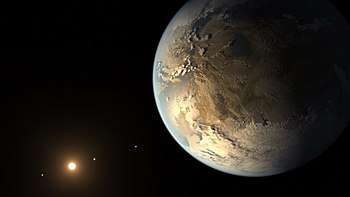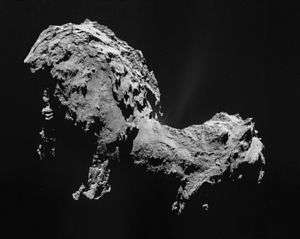2014 LY21
2014 LY21 is a micro-asteroid, classified as near-Earth object of the Aten group, approximately 4–8 meters (13–26 feet) in diameter. On 3 June 2014 22:38 UT (± 14 hours), it passed less than 0.00032 AU (47,900 km) from Earth around .[2] The asteroid was discovered on 2 June 2014 by the Mount Lemmon Survey at an apparent magnitude of 21 using a 1.5-meter (59 in) reflecting telescope.[1]
| Discovery[1] | |
|---|---|
| Discovered by | Mount Lemmon Srvy. |
| Discovery date | 2 June 2014 |
| Designations | |
| 2014 LY21 | |
| Orbital characteristics[2] | |
| Epoch 2 June 2014 (JD 2456810.5) | |
| Uncertainty parameter 9[2] | |
| Observation arc | ~1 hour |
| Aphelion | 1.0306 AU (154.18 Gm) (Q) |
| Perihelion | 0.35603 AU (53.261 Gm) (q) |
| 0.69330 AU (103.716 Gm) (a) | |
| Eccentricity | 0.48647 (e) |
| 0.58 yr (210.9 d) | |
| 203.00° (M) | |
| 1.7074°/day (n) | |
| Inclination | 0.80341° (i) |
| 73.788° (Ω) | |
| 348.77° (ω) | |
| Earth MOID | 0.000140028 AU (20,947.9 km) |
| Jupiter MOID | 4.29318 AU (642.251 Gm) |
| Physical characteristics | |
| Dimensions | 4–8 m (13–26 ft)[3] |
| 29.1[2] | |
Description
With an observation arc of about 1 hour, the trajectory is poorly constrained and the asteroid has an uncertainty parameter of 9 making long-term predictions of the asteroids position nearly impossible. The nominal (best fit) orbit shows that 2014 LY21 passed 0.00012 AU (18,000 km; 11,000 mi)[2] from Earth on 3 June 2014 (~11,600 km from Earth's surface).[4] But the uncertainty region shows that the asteroid could have approached Earth as close as 0.00006 AU (9,000 km; 5,600 mi) or as far as 0.00032 AU (48,000 km; 30,000 mi).[2] Since Earth has a radius of approximately 6,400 km, the asteroid did not come any closer than about 2,600 km from Earth's surface.
The nominal orbit shows that 2014 LY21 passed 0.001 AU (150,000 km; 93,000 mi) from the Moon on 4 June 2014.[2] But the uncertainty region shows that the asteroid could have impacted the Moon or passed as far as 0.0044 AU (660,000 km; 410,000 mi).[2] But it is very unlikely that the asteroid impacted the Moon.
References
- "MPEC 2014-L48 : 2014 LY21". IAU Minor Planet Center. 9 June 2014. Retrieved 9 June 2014. (K14L21Y)
- "JPL Close-Approach Data: (2014 LY21)" (last observation: 2014-06-02; arc:=~1 hour). Retrieved 4 April 2016.
- "Absolute Magnitude (H)". NASA/JPL. Retrieved 9 June 2014.
- "about 8,000 km above Earth's surface". Twitter: Ron Baalke. 9 June 2014. Retrieved 9 June 2014.


